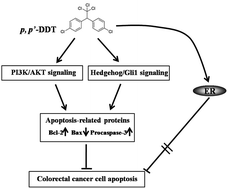p,p′-Dichlorodiphenyltrichloroethane inhibits the apoptosis of colorectal adenocarcinoma DLD1 cells through PI3K/AKT and Hedgehog/Gli1 signaling pathways†
Abstract
Dichlorodiphenyltrichloroethane (DDT) is a ubiquitous organochlorine pollutant in the environment and has been associated with colorectal cancer development. The present study investigated the possible effects of p,p′-DDT on the apoptosis of colorectal adenocarcinoma cells and the relevant molecular mechanism. The results indicated that exposure to low concentrations of p,p′-DDT (10−10, 10−9 and 10−8 M) for 96 h markedly inhibited the apoptosis of human colorectal adenocarcinoma DLD1 cells induced by 5-FU. Moreover, p,p′-DDT exposure led to upregulation of Bcl-2 along with downregulation of Bax and procaspase-3 in both DLD1 cells and tumor tissue of a mouse xenograft model. We also found that activated caspase-3 activity was decreased after p,p′-DDT treatment. The addition of estrogen receptor (ER) inhibitor, ICI 182780, had no significant effect on the action of p,p′-DDT. In addition, p,p′-DDT exposure could activate PI3K/AKT and Hedgehog/Gli1 signaling cascades. Treatment with the PI3K inhibitor LY294003 or the Hedgehog/Gli1 inhibitor GANT61 prevented p,p′-DDT-induced signaling pathways of PI3K/AKT and Hedgehog/Gli1, respectively. Consistently, LY294003 or GANT61 attenuated the ability of p,p′-DDT to suppress 5-FU-induced apoptosis in DLD1 cells. Taken together, our results demonstrated that p,p′-DDT inhibited the apoptosis of human colorectal adenocarcinoma DLD1 cells by activating PI3K/AKT and Hedgehog/Gli1 signaling pathways.


 Please wait while we load your content...
Please wait while we load your content...